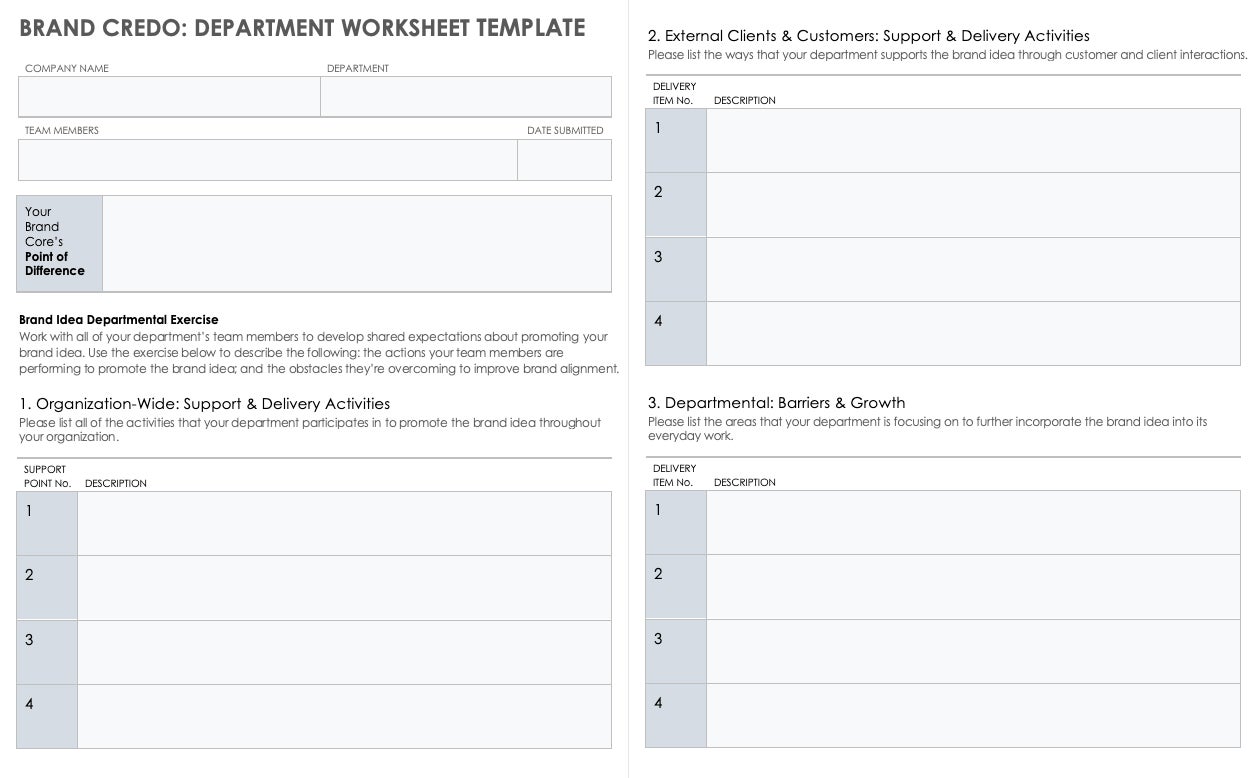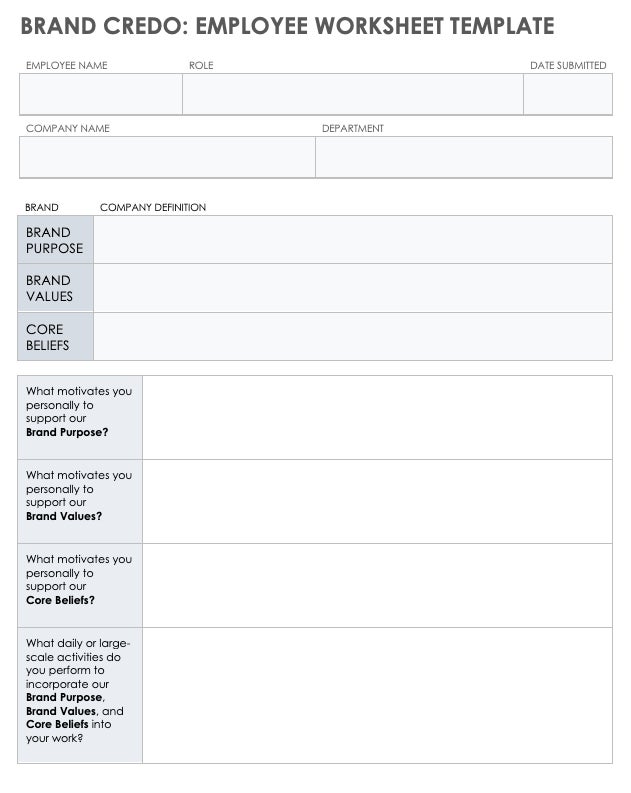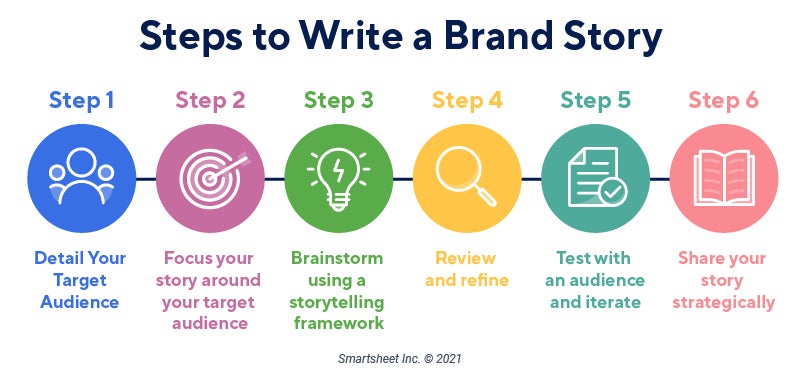Get branding tips and expert advice delivered straight to your inbox.
In this blog, you’ll learn how to write a compelling brand story with our step-by-step guide and pro tips. Plus, find a free brand story-building example template.
Included below, you’ll find detailed steps for writing a compelling brand story, brand credo worksheet templates, and a downloadable example brand story.
What Is a Brand Story?
A brand story is a narrative that communicates a company’s mission, evokes emotion, and builds customers’ trust. Customers who are moved by your brand story are more likely to count on your company and buy your products or services.
A well-crafted brand story articulates a specific customer problem and offers a compelling solution. In addition, it conveys a company’s purpose and values in an engaging, inspiring way. The most engaging brand stories are:
- Authentic
- Centered on the customer
- Consistent across channels
- Simple and clear with some vivid details
- Structured like a story
- True to your brand’s personality and voice
Effective brand stories offer more than just the facts; they recognize and appeal to a customer’s humanity and the need for community and connection. Humans are hardwired to connect to each other and their communities through stories, so the brands that are able to humanize themselves are the ones that stand out.
In a Harvard Business Review article, Harrison Monarth illustrates the connection between our neurological makeup and our response to storytelling, noting that “a happy ending to a story triggers the limbic system, our brain’s reward center, to release dopamine, which makes us feel more hopeful and optimistic.” Brand managers, marketers, entrepreneurs, and advertisers use this emotional response to drive sales, expand awareness, increase customer loyalty, and integrate their products into consumers’ everyday lives.

Understanding the importance of good storytelling is crucial when developing a brand story, but crafting a narrative that customers can connect with is challenging. Storytelling frameworks are a helpful tool for structuring an engaging narrative that will capture your ideal customer’s attention. Common story frameworks, like the hero’s journey or Freytag’s Pyramid, help focus a story and make it simple, memorable, and emotionally engaging. By using these frameworks to help structure your brand story, you can elicit a strong emotional response in customers and inspire them to deepen their engagement with your company through brand advocacy.
How Can a Brand Story Help My Company?
Brands need a compelling story to stay competitive in today’s market. A compelling brand story differentiates your company from its competitors, builds consumer trust and loyalty, and drives sales.
Anat Baron, brand building expert and keynote speaker, stresses the importance of brand stories in attracting and keeping customers. “People today want to know who they’re buying from,” she says, “and are even looking for a relationship with them. A brand story helps to build an actual relationship. Over the last 10-15 years, there has been a growing percentage of consumers who care about who they’re buying from. We’re in a place where consumers want to know their money is going to support either an entrepreneur or a big company that shares their values.”
A successful brand story helps you to do the following:
Differentiate Your Company: In today’s market, the majority of buyers purchase from companies that share their core values. An authentic story helps attract customers with similar values by communicating your brand’s mission and ideals in a succinct and engaging way.
Connect with Your Audience: A business’s reputation depends entirely on its connection with its customers. When customers connect emotionally to your story, and not just your product or service, they will be more loyal to your brand and more likely to recommend it to others.
Build Customer Trust: Your brand story establishes your brand promise and how you deliver on it. Following through on brand promises deepens your company’s connection with its customers and builds customer trust.
Drive Sales: Modern consumers look beyond price tags and good deals for a compelling story. A well-designed brand story drives conversions, encourages connection, and ultimately leads to sales.
Optimize Resources: Smaller retailers use their brand story to attract new customers, even without a big marketing budget. Small businesses have the advantage of consumer interest in local relationships, which increases sales and allows for small companies to scale more quickly.
“Brand stories have been around for a while,” says Baron, “but now it’s actually become a necessity. If you don’t have a brand story, it’s hard for people to get excited about you. We live in such a word-of-mouth world, where stories are ingrained in our humanity and the good ones are shared. Stories provide an emotional connection. Your key is to have an authentic brand story and to stick to that story. This is a recipe for success. If you communicate your story well to your target audience and continue to do so, it can drive all of your content and your engagement.”
In addition to reaching customers and building trust, brand stories are integral to developing a positive company culture. Graham Robertson, founder and CMO of Beloved Brands Inc, encourages people to use the brand story to “develop a shared understanding of the brand and talking points that help each employee articulate how their role delivers that brand idea.” The company’s employees are ultimately responsible for delivering brand messaging to its consumers. They are also part of the lived story.
As you create the consumer experience, “give the external and internal brand story equal importance. Everyone who works on the brand needs to use the brand idea as inspiration and to guide their decisions and activities across every function of the organization,” Robertson advises.
To do this, Robertson has developed a unique brand credo document as an internal version of your brand story. “Not only does the brand credo permeate through the company, but you will also likely hear it quoted in meetings daily.”
In Robertson’s words, he advises you can make a brand credo by following the steps below:
- Start with your brand idea and turn it into an inspiring promise statement, which explains to your people how they can positively impact your customers.
- Use your brand’s core point of difference to outline the expectations of how everyone can support and deliver the point of difference. A great exercise is to get every department to articulate its role in delivering the brand idea.
- Connect with your people by tapping into the personal motivation for what they can do to support your brand purpose, brand values, and core beliefs. Make it very personal.
Brand Credo Worksheet Templates
We’ve worked with branding expert Graham Robertson and his Beloved Brand framework to create department and individual employee brand credo worksheet templates to get you started on developing your brand story.
Use these free worksheets to brainstorm for your organization-wide brand credo. Once completed, assemble their contents and revise them into a beautifully written document to share internally. Larger companies may consider hiring a copywriter to assist with the final document. See Beloved Brand’s example below for an illustration of what a successful brand credo will look like:

Brand Credo Department Worksheet Template

Developed with branding expert Graham Robertson, this brand credo department worksheet template can be used as a tool to get various departments on the same page about how they communicate and carry out their brand promise.
Brand Credo Individual Employee Worksheet Template

Developed with branding expert Graham Robertson, this brand credo employee worksheet template is a tool to help employees tap into their individual motivations for supporting your brand promise, core values, and beliefs.
Who Are the Authors of Your Brand Story?
The authors of your brand story are both your branding team and your customers. Initially, your branding team produces and shares a brand story. Once customers interact with the brand, they complete the story with their perceived experience.
You can write your brand story internally or hire an agency to help develop it. If you hire an agency, use a brand brief to communicate your brand’s core values. Once the brand manager and team create the brand story, marketers tailor and distribute the message through multiple channels.
Customer feedback acts as a mirror to your brand story. After you share your story publicly, your customers will further define it based on their experience, either confirming or contradicting your intended messaging. When customers interact with your products or hear their friends and family talk about your brand, they fill in story gaps with their own experience. Brand managers use this feedback to further refine elements of the brand story.
Brand developers use an iterative process to ensure that their story revolves around the needs of customers. This process involves testing story drafts with audiences to see if the language, imagery, and throughline resonate before developers launch a story publicly. If the public responds negatively to a story after the launch, brand managers may tighten or change the story.
What Should a Brand Story Include?
Through concise, well-structured, and vivid storytelling, a brand story should communicate your core values and mission. In order to develop a story that reaches and resonates with your target audience, include these key elements:
Brand Strategy
Your brand strategy helps you achieve long-term goals and focus on your customers’ needs and emotions. Use your brand pillars and guidelines to express your company values and purpose, and employ a brand style guide template to make sure all communications reflect your brand’s tone, personality, and values.
Developing a solid, comprehensive brand strategy is an important investment of time and resources. In the long run, a brand strategy will help you tell your story more effectively and efficiently.
You’ll know you have a solid strategy when you’ve succinctly answered high-level questions, such as the following:
- What did we set out to do? Why?
- What value do we bring to the world?
- What makes us different from other companies?
- What problem does our product solve?
- Who do we help?
- What actions do we take that reflect our values?
You can also use a brand pyramid to build your brand’s core values from the ground up. A brand pyramid template is a visual tool that helps represent the fundamental characteristics of your brand, like:
- Features and attributes
- Functional benefits
- Emotional benefits
- Brand or product persona
- Brand idea or essence
Captivating Storytelling
A successful brand story should enable your target audience to articulate why you are different, how you help, and why they need your product or service. An audience will better understand and remember these details when your brand story delivers both functional information and emotional evocation.
A brand story that includes the following story elements promote audience engagement:
- A Story Arc: Set up a problem, create a solution, and celebrate the success of overcoming that problem.
- A Framework: Build your brand on an existing story framework. These frameworks naturally create tension and resolution within a story.
- Sticky Details: Create memorable stories by avoiding clichés and vague descriptions. Pepper in vivid details at pivotal moments of the story. Striking details help make a story more memorable.
- Brand Personality: Reinforce customer expectations by establishing your brand personality. Brand personality comes through in the voice and tone of your brand story and through personifications of characters, dialog, and objects.
- Simplicity: Keep your story simple. Cut anything that doesn’t serve a clear purpose.
Relatability
When you create a brand story, authentic connection with your target audience is essential. Leading with your brand values and company mission attracts customers with similar values. Your story must build trust, both on a functional and an emotional level, and inspire a sense of pride and community.
Shareability
Stories are meant to be shared, and that includes a brand story. Compelling stories contain elements like whimsy, wonder, awe, allure, and excitement that move people to share them with their friends. When consumers spread your brand story, you will quickly and broadly increase your traffic potential and conversion rate.
Founder Bios You may also wish to include executive bios in your brand story to help make your company more personable and approachable.
How Do You Write a Brand Story?
When writing a brand story, first identify your target audience. With this audience in mind, use a storytelling framework to create a story that appeals to their emotions, values, and needs. Ask for feedback and revise your story as many times as necessary to make it memorable and relatable.
Having a brand strategy in place before you begin writing your brand story will help keep your messaging focused. Use our complete guide to developing a brand strategy or download our free brand strategy templates to get started. Once you have developed a comprehensive brand strategy, you will be ready to begin.
With a developed brand strategy and a target audience in mind, begin to assemble your writing team. For larger organizations, Robertson recommends “building the brand story by using a cross-functional team, including salespeople, research and development, human resources, finance, and operations. This gives you a broader perspective and, once complete, helps with buy-in across the organization.” Small businesses and solo entrepreneurs can recruit trusted individuals to serve as a test audience.
Remember that storytelling, like branding, is not an exact science. Use existing frameworks to keep your story concise and well-structured as you explore creative possibilities. Remember to refer frequently to your brand strategy to keep your story focused on relevant goals.

1. Identify Your Target Audience
List the key demographics of your ideal customer. Some examples of target audiences are:
- Established professionals
- Luxury car owners
- Homeowners
- Eco-conscious consumers
- Home maintenance service subscribers
2. Focus Your Story on Your Target Audience
After identifying your target audience, list specific problems and anxieties they may face and what drives them to action. Use the following questions to help as you begin to brainstorm:
- Why do they stay up at night?
- What are they anxious about?
- What makes them frustrated?
- What makes them smile?
- How do they prioritize their day?
- What is important to them?
Robertson suggests that you “start your brand with a consumer insight (connection point) or consumer enemy (pain point) to captivate the consumer enough to make them stop and think, ‘That’s exactly how I feel.’”
The next step to developing your brand story is identifying how your company can address and alleviate the specific problems you have identified. In a 2016 Harvard Business Review article, authors Clayton Christensen, Taddy Hall, Karen Dillon, and David Duncan suggest that you imagine your customers are “hiring” your product to perform a task. “When we buy a product,” they explain, “we essentially ‘hire’ it to help us do a job. If it does the job well, the next time we’re confronted with the same job, we tend to hire that product again. And if it does a crummy job, we ‘fire’ it and look for an alternative.” When applying this technique, ask yourself: What is the job that your customer is hiring your product to perform?
Tip: Baron urges brand designers to ask how their products are solving problems in everyday life. “Not every product is a solution,” she explains. “Products that are aspirin are musts. Vitamins are wants. Think about your product in that way. It’s a question of wants and musts. The more you can make yours a must, the more compelling it becomes.”
3. Brainstorm Using a Storytelling Framework
Choose a storytelling framework and begin brainstorming. At this stage, let the ideas flow without editing. The goal is to build a solid story structure, with a captivating beginning, tension-building middle, and a satisfying resolution. You will refine and edit your ideas later.
Tip: Baron recommends telling the truth in your origin story. “It [makes it] easy to write because it’s true and comes from an authentic place,” she says.
Review the following common storytelling frameworks. If one jumps out as particularly inspiring or well-suited to your brand, use that basic structure to being brainstorming for your brand story:
- Hero’s Journey: The hero’s journey follows an ordinary person’s path as they leave home to venture into an unknown world and return home changed. The stages of the hero’s journey are:
- Separation: The hero leaves home. Often, the hero feels reluctant to embark on their journey and is averse to change.
- Descent: The hero travels to a world unknown.
- Initiation: The hero experiences a series of trials that lead to encountering the primary enemy.
- Return: The hero returns home. Home is the same, but the hero has been changed in some fundamental way.
Imagine your ideal customer as the hero of the story. Does your product initiate your hero’s journey? Does it help bring your hero home in the end? Situating your product within the arc of the hero’s journey will help potential customers visualize your brand as a key part of their own story.
Origin Story: One of the most common structures for a brand story, an origin story situates a company’s current values and mission in the context of its past. These brand stories help customers understand why you started doing what you do and where you hope to go. An origin story will answer the following questions:
What is the company’s history?
Where and when was your company founded?
What is your company’s purpose, value, and culture?
What does your company do?
Why does your company do what it does?
While facts and figures are helpful and have a place in origin stories, remember to keep your story human. Don’t be afraid to share hardships you’ve had to overcome. People relate to passions, imperfections, and challenges, and sharing these with your customer will help them connect to your brand.
- Freytag’s Pyramid: Gustav Freytag, a 19th-century German novelist and playwright, developed a five-part narrative structure that he based on the most timeless fictional storylines. These five stages are the following:
- Exposition: The narrator introduces the world of the story, establishing elements such as setting and characters.
- Rising Action: Characters begin facing conflicts and challenges, including one larger, overarching challenge, that create a sense of tension.
- Climax: At the apex of the pyramid, the protagonist reaches a turning point. Conflicts come to a head.
- Falling Action: With the major conflict behind them, characters process what has happened and the drama begins to settle.
- Resolution: The narrator ties up loose ends and creates a sense of resolution.
Use Freytag’s Pyramid to build tension and resolution into your story and help make it memorable and exciting.
- Pixar Story Framework: Former Pixar storyboard artist Emma Coats developed the following simple framework for telling any story:
Once upon a time . Every day_. One day . Because of that. Because of that. Until finally _____________.
Use the Pixar Story Framework to help simplify a brand story that is overly complex and to get to the emotional center of your story quickly.
4. Write, Review, and Refine
Once you’ve brainstormed and outlined your story, it’s time to write and refine. If you take the time to work through these steps and structure your story ahead of time, the writing becomes much easier. Remember to maintain a tone that is consistent with your brand style guide and persona.
Polish your document with a thorough editing process. Check for grammar, spelling, and syntax errors. Read your story out loud to yourself. Step away from it and return with fresh eyes. Seek feedback. Where is your story compelling? Where are you bored? Does it follow the brand style guide? As you refine, consider your story’s relatability, memorability, authenticity, and shareability. Check that you are doing the following:
- Keeping the tone conversational
- Showing personality
- Being real
- Ending on a positive note
- Using real-world examples, such as case studies or employee stories
- Connecting with customer’s needs
- Highlighting conflict and resolution
- Writing in your brand voice and tone
- Stating your mission as simply as possible
5. Test with an Audience and Iterate
Once you’ve gone through internal edits, seek external feedback. If your company has ample resources, you might conduct formal consumer testing. If your company is smaller and less established, you might share your brand story with a trusted friend or colleague. Ask them non-leading questions to get feedback on how the story emotionally and functionally resonates. Some example questions include the following:
- How did the story make you feel?
- How does the company make a difference?
- What places in the story were you bored?
- Did the characters and their plotline move you? How so?
- What is needed to make the story more compelling?
- What parts aren’t necessary?
Return to your story and incorporate this external feedback. Repeat the process with multiple test groups before you finalize your draft.
Tip: Baron says the most important thing is to continually ask yourself, “How can I make this as compelling as possible so that it’s interesting and repeatable?”
6. Share Your Story Strategically
Share your story through all relevant channels and tailor it for each channel. Display it on the center of your landing page. If your company has physical stores, make sure it is visible to customers when they enter. As you receive feedback, make incremental changes to improve your story over time.
Robertson encourages brand developers not to be shy about where their brand story appears. “The brand story becomes the ‘who are we’ page on your website or LinkedIn page,” he explains. “It becomes the introductory slides to a sales pitch presentation, how you project yourself to potential investors, or your message to your team to inspire their best performance.”
Tip: Baron urges brand developers to “get big on social media. The best stories are now happening on Tik Tok. Movies have gotten shorter because our attention has gotten shorter. Figure out what is the essence of the story to build around it to make it compelling and memorable.”
Brand story development doesn’t end with publication. Part of a brand story is a brand’s continued engagement with customers. After you post your story, invest time in the following:
- Engage with customers by responding to user comments.
- Encourage customers to share your story.
- Track social media metrics to see which versions of your story get the most attention.
- Analyze your metrics and use these insights to adapt and improve your story in the future.
Not sure where to start? Develop a brand communication strategy to determine the marketing channels for your brand communication plan. For more information and resources, see our guide on developing a brand communication strategy.
Building a Brand Story Template Example

Use this customizable brand story building example template as a resource for developing your own. Download and follow the easy-to-follow instructions to detail your company history, mission, strategy, and to develop your brand’s persona.
Check out our complete selection of brand story templates for a comprehensive list of story-building resources.



